“Public discourse has been polluted now for decades by corporate-funded disinformation - not just with climate change but with a host of health, environmental and societal threats. The implications for the planet are grim.” -Michael E. Mann
What a couple of weeks it's been, both at Starts With A Bang and beyond, as I had a trip to MidSouthCon spin my head around last weekend. And even though we were a little short on articles and on time, you certainly let me (and each other) have it with your comments, both last week and this past one. If you missed anything, we hit on:
- Could our Universe be a hologram? (for Ask Ethan),
- New map of the Milky Way is complete (for Mostly Mute Monday),
- 10 quantum truths about our Universe (an impressive romp by Sabine Hossenfelder),
- The next great global warming hiatus is coming (with over 100 comments and counting!),
- Most planets in the Universe are homeless,
- Could dark energy recycle the Universe? (for Ask Ethan),
- Most massive collection of giant stars ever revealed by Hubble (for Mostly Mute Monday),
- What it means if CERN discovers a new particle,
- NASA's Dawn probe solves Ceres' multiple mysteries,
- Could dark matter not exist at all?, and
- Why do the tiniest galaxies have the most dark matter?
If you didn't make it to MidSouthCon, I strongly encourage you to come to Balticon 50 this Memorial Day weekend in Baltimore, MD, where I'll be speaking, selling and autographing books, and reprising some of my favorite costumes as well as breaking out a new one, that saw the light of day for the first time at MidSouthCon this past weekend:
 Image credit: photograph by Frank Tuttle of King Triton and Ursula the sea witch from the Little Mermaid at MidSouthCon 34.
Image credit: photograph by Frank Tuttle of King Triton and Ursula the sea witch from the Little Mermaid at MidSouthCon 34.
Now that you've got a hint of what's gone on, let's take a trip into our Comments Of The Last TWO Weeks!
Image credit: Alex Dunkel (Maky) and Polytope24 of wikimedia commons, under a c.c.a.-by-s.a.-3.0, of the AdS/CFT correspondence between the interior volume and the boundary of the surface enclosing it.
From See Noevo on whether the holographic Universe is science: "Is THIS science?
“Now, our Universe as we actually perceive it has three spatial dimensions accessible to us. But what if there are fundamentally more than that? Just like a common hologram is a two-dimensional surface that encodes the full suite of information about our three-dimensional Universe, could our three-dimensional Universe encode information about a fundamentally four-or-higher-dimensional reality that we’re embedded in?""
In general, science is an iterative process, where you say something to yourself like the following:
- What is the full suite of evidence currently available that relates to a certain phenomenon or set of phenomena?
- What are the possible theories, models and scenarios that are consistent with the full suite of these phenomena?
- What are the implications of those hypotheses, how do they differ and how can they be tested?
- Let's work to perform those tests, get some data/observations/measurements and then go back to step one!
It sounds like you won't call this science until you get to step four, but this is completely part of the scientific process. So to answer your question, yes, and that is how.
 The latest composite release, from the ATLASGAL collaboration. This map spans nearly half of the Milky Way and covers over 400 square degrees on the sky, at a wavelength of 870 microns. Image credit: ESO/APEX/ATLASGAL consortium/NASA/GLIMPSE consortium/ESA/Planck.
The latest composite release, from the ATLASGAL collaboration. This map spans nearly half of the Milky Way and covers over 400 square degrees on the sky, at a wavelength of 870 microns. Image credit: ESO/APEX/ATLASGAL consortium/NASA/GLIMPSE consortium/ESA/Planck.
From PJ on the entire Milky Way in a new wavelength of light: "( picks chin up off floor) F F F F fabulous ! ! Thanks, Ethan …"
I still can't really get over that this was done in the far-IR from the ground! What an accomplishment!
From CFT on quantum truths and confusion: "Part of the problem is the model. Get rid of the Bohr atomic model/diagram (it’s next to useless mechanically) and adopt a model that actually represents the mechanical functioning of the nucleus."
Oh my, the Bohr model was never meant to address any of the issues of the nucleus at all! Rather, Bohr-Sommerfeld quantization was designed to explain the energy levels of the atom, and to explain the big problem with the Rutherford model of why electrons didn't radiate energy away and spiral into the nucleus on short timescales. (Which is what happens, by the way, in positronium!) The Bohr atom doesn't explain all of quantum physics, but it is incredibly useful for what it does, and that's why we still use it. You don't use Einstein's GR to calculate how objects fall to the ground in a vacuum; you could, but that's a lot of extra work for practically zero useful extra information, and that would be the case in going beyond the Bohr atom for an atom's energy levels.
From SteveP on... well, the Culture Wars, I guess: "We are fighting the whole denialist tribe these days, but one group that we really need to watch out for are Tribe Trump, a tribe that depends on intimidation as its main defense mechanism, kind of like a hog nose snake."
I come at all of this from a scientist's point-of-view: you look at the full suite of evidence for a phenomenon, you draw the best conclusion the data allows you to draw, and then you present it to the world. You present it as the scientific truth, with the caveats of all the uncertainties that are legitimate but without the illegitimate ones, and it remains the truth to the best of our knowledge despite what anyone else says. I consulted multiple independent climatologists in putting together my piece and made sure they all signed off on the finished version; they all agree this is correct. I do not assert that the tactics I use are the only viable ones, but we all have our role to play in pushing the world closer towards the world we want it to be.
Image credit: Japan Meteorological Association (JMA), of the monthly average temperatures in February, going back as far as temperature records do. Via the Sydney Morning Herald at http://www.smh.com.au/environment/climate-change/true-shocker-spike-in-….
From David Ging on the global warming story: "The problem with arguments about global warming is that there are really 3 separate arguments and people arguing of them and think they are proving another. But they aren’t. The three arguments are 1) basic climate change. The earth is warming. There’s little doubt this is happening. 2) Man-made global warming (AGW). The earth is warming and man is at least partly responsible for it. There’s solid evidence for this. 3) The earth is warming, man is largely responsible and it will have dire consequences (CAGW)."
There is a fourth part as well: that there is something/nothing we can/could/should do about it. The rest of your comment was about how there are no dire consequences; perhaps you should tell that to California farmers or the entire country of Peru's agricultural system?
Average of NASA GISS, NOAA NCDC, and HadCRUT4 monthly global surface temperature anomalies from January 1970 through November 2012 (green) with linear trends applied to the time frames Jan ’70 – Oct ’77, Apr ’77 – Dec ’86, Sep ’87 – Nov ’96, Jun ’97 – Dec ’02, and Nov ’02 – Nov ’12. Image credit: Skeptical Science at http://www.skepticalscience.com/does-global-warming-pause-mean-what-you….
From Denier on global temperatures: "It is good to see that we agree. We agree that this year is warm and those record temperatures are being driven by an El Nino event. We agree that the climate has continued to warm dating all the way back to the start of the most recent Interglacial Period. We agree that there is a natural variability to Earth’s climate in both short and long time scales."
As a fun fact, 2015 was the warmest year on record, and approximately 0.1° C was attributable to El Niño. The additional effects of this weather pattern on temperatures only began in the fall, although it is continuing right now, which is why February temperatures were so high. In other words, without El Niño, 2015 would've still been the warmest year on record. With it, 2016 is projected to be that next outlier "spike" in temperatures, and when 2017, 2018, 2019 and 2020 are all cooler than 2016 (and possibly than 2015 and 2014), I expect the "global warming has slowed, paused, stopped or reversed" crowd to start making disingenuous arguments once again, as they were doing ca. 2010. This article was an attempt to get out in front of that.
From Eric on failed stars, orphaned planets and mass fractions: "Ethan, you made a big point about these orphans being made from the lighter gasses blown away from the stars, and them being ‘almost stars’ that didn’t ignite. Wouldn’t that mean that we expect most of them to be gas giants? It seems strange then to say that these orphans may or may not have atmospheres, given that – if I’m reading your article correctly – you really expect most of the orphans to be gas giants."
I don't think that's fair at all. Here's the deal with what happens during star formation, in rapid-fire fashion:
- A cloud of gas that's cold enough to collapse has overdense regions of various magnitudes.
- The greatest overdense regions attract matter the fastest, growing and becoming stars (and the most massive stars, at that).
- The less overdense regions attract matter more slowly, growing into clumps anywhere between asteroid/comet sized in mass to rocky planet masses to gas giant masses to small stellar mass objects.
- In the meantime, the brightest stars burn bright and hot, and ionize the tenuous gas of the nebula, breaking it up and quenching (stopping, via feedback) further star formation.
So what's left after that? First off, the vast majority of the material from the nebula gets blown back into the interstellar medium in the form of an ionized plasma. Second, the stars and young planetary systems are still around, and represent the majority of the leftover mass. But there's another component that's important: the matter that was dense enough to clump together into massive objects, but that wasn't dense enough to form stars. These are the planets-born-without-parent-stars populations. Was the ultraviolet radiation from the nebula hot enough to strip off the hydrogen/helium envelope from the world in question? Then it's a rocky planet. Was it not? Then it's a gas planet. There will be a mass distribution of these objects that we can theorize about by extending, say the Salpeter IMF, but but there are lots of uncertainties there. That's what I have to say about that.
From Ming the Merciless on the counterpart of ejection, which is capture: "In light of this, are all the planets in our solar system ‘native’ or is one or more adopted. Uranus is weird. Not only on its side but also inert."
Uranus fits in very well with the orbits of the gas giants in a stable resonance, as the semimajor axes of Jupiter, Saturn, Uranus and Neptune are roughly 5, 10, 20 and 30 AU, respectively. Uranus is exactly the density we'd expect an intermediate planet between Saturn and Neptune to have, as are the densities of its moons. And as far as the molecular composition of the planet, it's consistent as well. It's extraordinarily unlikely that it's adopted, based on this. In other words, I don't think Uranus is weird enough for that.
A combination of instruments on the ESO’s very large telescope reveals wide-field and narrow-angle views of the Tarantula Nebula. Image credit: ESO/P. Crowther/C.J. Evans.
From Omega Centauri on the heavy metal content of the stars in the Tarantula Nebula: "Ethan low low is the metallicity of these gas clouds. Opacity due to metals is supposed bad for very high mass stars, as radiation pressure threatens to outstrip gravitational attraction. I’ve presumed that the LMC probably didn’t have a large amount of star formation (and evolution of the gas clouds) prior to interacting with the Milky Way. Is this borne out by observational evidence?"
So we don't have metallicity measurements for these stars. But we do have metallicity measurements for just slightly older stars: the cluster Hodge 301 in the Tarantula Nebula, which is estimated to be 20-25 million years older than the stars in 30 Doradus and in particular than the cluster R136.
 The star cluster Hodge 301 (lower right) in the Tarantula Nebula, by Hubble. Image credit: The Hubble Heritage Team (AURA / STScI / NASA).
The star cluster Hodge 301 (lower right) in the Tarantula Nebula, by Hubble. Image credit: The Hubble Heritage Team (AURA / STScI / NASA).
Compared to the Sun, which has a metallicity of Z = 0.02 (meaning ~2% of its mass is due to elements heavier than helium), these stars have a metallicity of Z = 0.008, or about 40% the metals in the Sun. That's lower than our metallicity, but it's not so catastrophically bad that it presents a problem. For what it's worth, metals play an important role in the cooling and dissipation of young stars, but more quantitative information is beyond my expertise. Any astronomers here who specialize in that?
This map shows a portion of the northern hemisphere of Ceres with neutron counting data acquired by the gamma ray and neutron detector (GRaND) instrument aboard NASA’s Dawn spacecraft. Image credit: NASA/JPL-Caltech/UCLA/ASI/INAF.
A good comment from Denier on Ceres, which gives me a chance to clear up some information about it: "I’m having a hard time reconciling finding #1 and finding #2.
Finding #1 – An impactor [in the Occator crater located less than 20 degrees north of the equator] kicked up sub-surface volatiles and water. Minerals dissolved inside the water, and when the water evaporated/sublimated, the salts were left behind.
Finding #2 – The likely presence of sub-surface ice, but only at the poles."
The resolution lies in at what depths this sub-surface material is. The image above, which shows the neutron counting data -- that definitely shows a strong signal from the poles -- offers information only about the top three feet of surface material. We don't see water-ice anywhere on the surface except for Oxo crater, but this data is consistent with there being water-ice in that top three feet at both poles. (Only one pole is shown in the image.)
But going way down there -- as in multiple kilometers -- there's a whole unknown set of materials that may have been uncovered. So I hope that helps clear up that discrepancy.
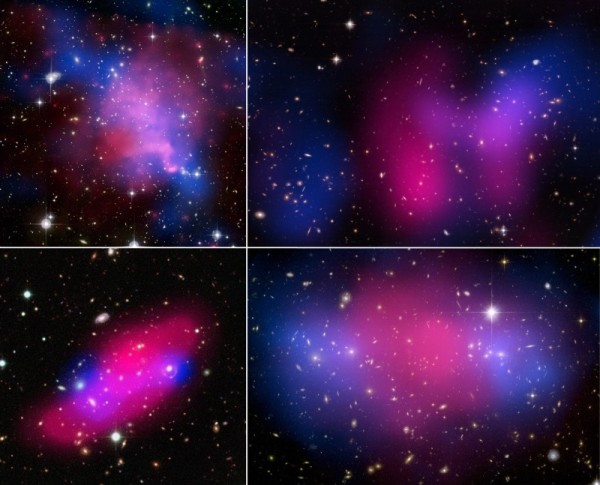 Images credit: X-ray: NASA/ CXC/UVic./A.Mahdavi et al. Optical/Lensing: CFHT/UVic./A.Mahdavi et al. (top left); X-ray: NASA/CXC/UCDavis/W.Dawson et al.; Optical: NASA/STScI/UCDavis/ W.Dawson et al. (top right); ESA/XMM-Newton/F. Gastaldello (INAF/IASF, Milano, Italy)/CFHTLS (bottom left); X-ray: NASA, ESA, CXC, M. Bradac (University of California, Santa Barbara), and S. Allen (Stanford University) (bottom right). These four separate groups and clusters all show the separation between dark matter (blue) and normal matter (pink).
Images credit: X-ray: NASA/ CXC/UVic./A.Mahdavi et al. Optical/Lensing: CFHT/UVic./A.Mahdavi et al. (top left); X-ray: NASA/CXC/UCDavis/W.Dawson et al.; Optical: NASA/STScI/UCDavis/ W.Dawson et al. (top right); ESA/XMM-Newton/F. Gastaldello (INAF/IASF, Milano, Italy)/CFHTLS (bottom left); X-ray: NASA, ESA, CXC, M. Bradac (University of California, Santa Barbara), and S. Allen (Stanford University) (bottom right). These four separate groups and clusters all show the separation between dark matter (blue) and normal matter (pink).
From Michael Kelsey on CDM and MOND: "CDM is part of a theory about the large scale structure of the universe. Starting from the assumption of conventional gravity, we can use the observed gravitational effects of CDM (what we “presume” to be CDM) to directly calculate the missing mass density. That calculated density can then be turned around and used to predict effects on different length scales, such as the solar system. If you work through the relatively straightforward math, you discover that local effects are unobservably small. So we can’t directly confirm CDM on sub-galactic scales, but observing larger visible effects (which we don’t) would be a fairly convincing refutation.
Conversely, MOND alone does fit galaxy rotation curves better than CDM by itself, but because it is meant to be a generic theory of gravity, it can also (and *MUST* also) be applied to all other gravitating systems, including galaxy clusters, lensing systems, the solar system, and so on. It fails on two different counts: first, at solar-system or subgalactic scales, MOND makes predictions which are at variance with the observed behaviour of both planetary objects and spacecraft. On larger scales, MOND predictions are at variance with observed cluster motions and with gravitational lensing, unless additional (dark!) matter is included."
I have always been of the opinion that the goodness-of-fit of MOND on galactic scales can and should be used to help us fit what our best interpretations of dark matter should be, but that dark matter -- which not only gives us large-scale structure but also the peaks in the CMB and the correct predictions for (the low value of baryons in) Big Bang Nucleosynthesis -- is likely the all-encompassing explanation. Exactly what flavor of dark matter that is remains to be seen!
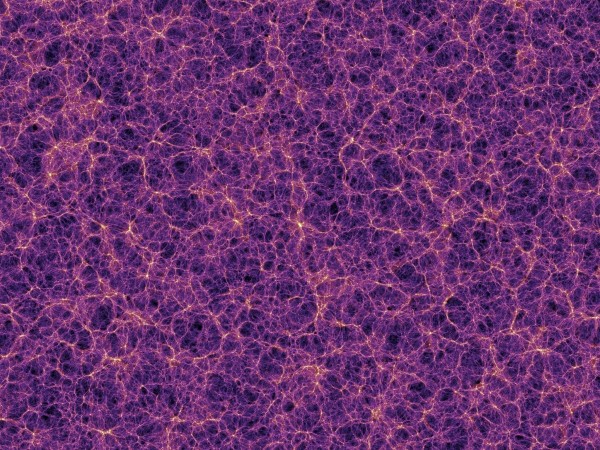 Image credit: The Millenium Simulation, V. Springel et al., of the cosmic web of dark matter and the large-scale structure it forms.
Image credit: The Millenium Simulation, V. Springel et al., of the cosmic web of dark matter and the large-scale structure it forms.
From Patrick Sweetman on whether this was old news: "This seems very very familiar. Is it a reprint?"
About once a week -- usually on Thursday or Friday (for throwback thursday or flashback friday, as it were) -- I go deep into my archives, pull out an old article, and update anything that needs updating to run it again. Some stories are so good or so important that they're worth re-telling from time to time. Good eye!
From Mephistopheles O'Brien on an outlandish idea: "A while back someone (apparently seriously) suggested that dark matter was the cause of some extreme weather effects such as tornadoes and hurricanes."
You can always find someone who sets a new bar for crazy, based on a novice misunderstanding of a well-understood idea. Such as our final comment of the last two weeks...
From Ben Fulton on providing exactly such an example: "Dark matter is not a clump of stuff that travels with the matter. Dark matter fills the space unoccupied by particles of matter and is displaced by the particles of matter which exist in it and move through it. Dark matter strongly interacts with matter. Dark matter is displaced by matter."
This is absolutely a string of sentences full of misinformation that has no bearing in reality. Dark matter is experimentally shown to not interact via the strong force or the electromagnetic force. It may interact through the weak force (although, if so, it would be more weakly than any other known particle), and it definitely interacts through the gravitational force. There may be other, "dark forces" that have not been discovered yet, and it is possible that there's an exclusion rule that applies to either dark matter particles on their own (or not) or to dark matter/normal matter interactions. But the idea that dark matter is displaced by normal matter runs counter to the evidence that dark matter appears where normal matter does, and that its gravitational effects show up there as well.
In other words, your line of thinking is a misinterpretation of the evidence and a misunderstanding of the words that physicists use when we describe things like forces, interactions, dark matter and normal matter. So stick around, listen, and learn, because I'll keep sharing stories about the Universe for as long as I can!



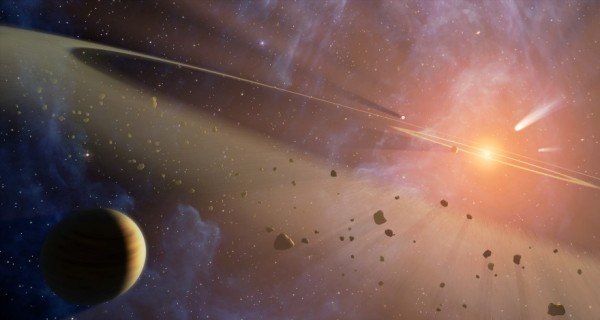

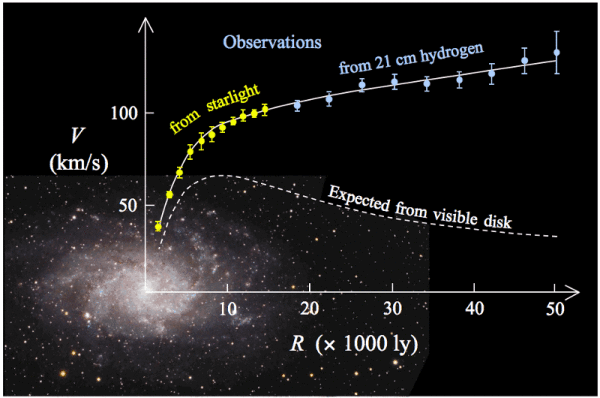
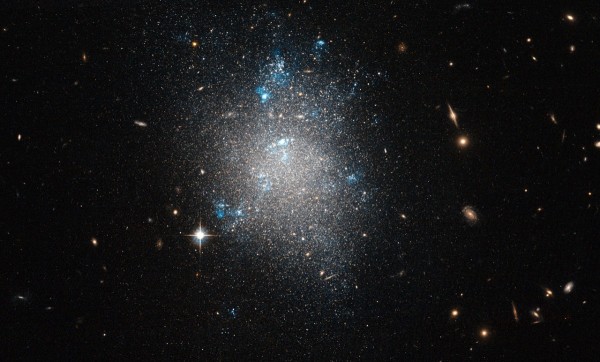
On the one hand you were kind of asking for it, only taking the chart back to 1890 (aka decades into the industrial revolution, when the smarter scientists like Arrhenius were starting to realize this might have an effect on the climate).
On the other hand, this doesn't mean Denier is right: temperatures *haven't* risen constantly since the ice age, they started rising only in the last few decades of our era. A chart with a longer baseline shows that.
I'm not sure about your argument that Uranus' properties intermediate with Saturn and Neptune is evidence Uranus formed between Saturn and Neptune. Doesn't the Nice model hypothesize that Uranus *didn't* form between Saturn and Neptune, as a way of explaining otherwise puzzling properties?
They suggest an outward-migrating Saturn threw Neptune out beyond Uranus, throwing the Kuiper belt into disarray and triggering the Late Heavy Bombardment. Then the planets finally settled into their present 2:5, 1:3, 1:2 commensurable periods?
@ Ethan:
… the idea that dark matter is displaced by normal matter runs counter to the evidence that dark matter appears where normal matter does.
Except, apparently, in the vicinity of the world’s ever expanding collection of increasingly sensitive dark matter detectors.
Just as an aside, have any papers been produced about the discovery made in late 2014 of a mysterious invisible barrier to ultrarelativistic electrons between the van Allen belt’s inner and outer zones?
Could DM be a possible causal candidate? Bearing in mind your comment:
… it is possible that there’s an exclusion rule that applies to either dark matter particles on their own (or not) or to dark matter/normal matter interactions.
@Alan L. #3
Yes. It is an interaction between electrons and the Earth's plasmaphere. There is published work available. See here: http://www.nature.com/nature/journal/v515/n7528/abs/nature13956.html
No. DM isn't a barrier to anything. Being a barrier requires interaction. Most believe DM to be sterile and not interact via any means other than gravitationally. As such the effects of DM cannot be detected on anything smaller than a galaxy. If whatever phenomena you are thinking about is smaller than a galaxy, then DM has nothing to do with it.
@Ethan
You seriously believe the El Niño conditions only contributed 0.1° C? Seriously?!? Is it just pure coincidence in your version of reality the temperature spike in 1998 and 2015/2016 were also El Niño years? ...And the timing of the weather pattern that has nothing to do with El Niño but is causing all the warming coincides exactly with the peak of El Niño is nothing more than lucky chance? I'm thinking you may want to put quotation marks around the word 'fact' in your rather far fetched 'fun facts'.
@Ethan
I was trying to figure this comment out. Seeing as SteveP identified himself in the thread as a climate scientist and seemed to be obsessed with politics, was your response a dig at him? Or were you agreeing that stopping a particular candidate's supporters is the most important part of the science?
Or perhaps you should spend the 30 or so seconds needed to, y'know, look it up rather than cherry-picking.
@Narad #7
from your linked blog post:
"We think El Niño made only a small contribution..."
"it’s impossible to get an exact answer to “what if El Niño hadn’t happened?”"
"Schmidt estimated..."
" Dr Thomas Cropper, a climate scientist at the University of Sheffield, has estimated..."
@Narad, do you know the difference between an opinion/estimate/theory and a fact? One of the biggest problems in all of climate science is the false certainty. Even @Ethan has remarked on needing to be honest with the margin of error, and then he turns around and does the same thing.
So, your response is not just more cherry-picking, but embarrassingly dumb cherry-picking that completely ignores your orginal assertion?
@Narad #9
Your response make me wonder if you know what cherry-picking is.
*plonk*
"I come at all of this from a scientist’s point-of-view: you look at the full suite of evidence for a phenomenon, you draw the best conclusion the data allows you to draw, and then you present it to the world. You present it as the scientific truth, with the caveats of all the uncertainties that are legitimate but without the illegitimate ones"
When you are dealing with Politics and "Truth" the truth is this, there is about as much "Science" in the "Political Science's" studies as there are "Science" in the Gay and Lesbian or Afro Blah,Blahh.. OR What the heck ever goofy ass studies dept. that is not about Basic Earth Science Study.
People of hard Sciences should realize that their hard work in namesake of "Science" IS BEING HIJACKED.
TRUE Scientist, don't be afraid to say #Gay_Studies_DONT Matter
#earth_science matters!!!
#social_science_is_NOT_science
Ethan: "It sounds like you won’t call this science until you get to step four, but this is completely part of the scientific process. So to answer your question, yes, and that is how."
And it's one of the problematic issues with demanding strict falsifiability for it to be "science" (see your previous comments on String Theory, whether it is a scientific theory or not).
"On the one hand you were kind of asking for it, only taking the chart back to 1890 (aka decades into the industrial revolution,"
Well, the North American Indians weren't really setting up weather monitoring stations and keeping records of thermometer readings. Before 1890, the record is quite sparse, and it only gets usefully wide coverage to give an indication of GLOBAL temperatures from 1880 onwards.
If you invent a time machine and give the Amerindian a few thousand thermometers and ask them nicely to keep records, feel free to extend the record back.
"Except, apparently, in the vicinity of the world’s ever expanding collection of increasingly sensitive dark matter detectors."
The word "apparently" indicates some appearance of truth. Care to supply that there's no chance of "enough" dark matter around any detectors?
TIA.
"You seriously believe the El Niño conditions only contributed 0.1° C? "
Yes.
The NAI is lower than the 1998 one, and we have models accurate enough to indicate the effect.
You seriously think it was more than that?
Other than the belief that it cannot be AGW, what else do you have of evidence for that?
“it’s impossible to get an exact answer to “what if El Niño hadn’t happened?””
Do you either
a) think that correct, in which case, how do you know it's more than 0.1C?
b) think it isn't correct, in which case, where's your evidence?
"Teddy Cruzer"
Piss off tabagger.
Ethan, this moron is trying another pair of socks on.
"Piss off tabagger.
Ethan, this moron is trying another pair of socks on."
Please Shut Up oh Worthless One.
You'r such a sniveling tattletale baby, Your a Judy Hensler:
https://en.wikipedia.org/wiki/Judy_Hensler
Miss Landers, Beaver is doing this.. Miss Landers Beaver is doing that .. Look At Me Miss Lander's I am the perfect student..
Wowzer, the only thing perfect you are at being is...being a little dope and a lota dork.
Oh and BTW.. I post on a lot of devices from a lot of locations and take little time to see what moniker .
Ethan can certainly vouch that from my location now on the road I am in fact in Title Town which is not my home base..
So You can in fact Piss Off... Tardface
I'm not sure I heard that right. You are admitting to using multiple different login names to post here? Being short on time is no excuse at all; it takes the same few seconds to write "Teddy Cruzer" as it does your original moniker.
It's also a completely assbackward proclamation. The teabagged moron never used it before, was caught before, said "sorry" before, "I'll not do it again" before, but really doesn't give a shit for either honesty, their word, or private property.
Unless that private property is "his".
He's just flat out lying. It's not like he couldn't have, when he was replying, reset his login to the "right" pseudonym.
The little shitbag just got caught lying and is doubling down like the retard he is.